Executive Summary
A dynamic and fast-paced world dictates a constant necessity for proper management of the process of reorganization. Given the growing theoretical and practical interest for change management especially in the public sector setting, the current research is devoted to studying change management in public sector setting. The study utilizes quantitative and qualitative approaches within longitudinal framework to assess the effects of change management on paperless environment project in General Civil Aviation Authority. The results of the quantitative study feature confirmation of the high value of change management for GCAA setting together with extreme care of managers for the change needs of subordinates, and significant impact of change management on cost, time and performance of the paperless environment project. The qualitative study confirms the results of the quantitative and reveals deep coherence with other theoretical works on change management.
Introduction
The technological progress drives almost all spheres of human activity forward towards more rapid, efficient, and effective achievement of the expected results. Management is no exception. New approaches to personnel handling, advanced methods of financial accounting, electronic means of communication emerge constantly. Until the second half of the 20th century the environment in which most of the organizations functioned may have been characterized as stable and the occurrences of new developments were relatively rare (Phillips, 1983). A new epoch of fierce competition for growing domestic and international markets ushered rapid change in methodological, managerial, and technological spheres. There steadily developed a demand for means to keep pace with the changes both for those responsible for their implementation and for those who are directly affected by them. The need for alterations stems either from the organizational insecurity or the desire to optimize the processes in order to maximize performance. Regardless of the motivation for the implementation of adjustments, there is always a necessity for proper management of the process of reorganization. However, according to Kang (2015), around 70% of interventions fail, which speaks further to expanding the understanding and use of change management (CM) in organizations.
Everett Rogers was one of the first to realize that change has to be closely examined and analysed in multiple contexts in order to develop an understanding of its correlation with time, communication, performance, subordinates and executives (Kang 2015). In the 1980s, more scientists and company people became interested in further development of the concept. Change management has become an industry where companies and individuals specialized in assisting other organizations and sole proprietors to facilitate minor and major reorganization (Kang, 2015). In a new millennium, new approaches to change management arose with the growing dissatisfaction of older top-down methods. Linda Anderson revolutionised change management introducing a practice of placing a special ground-level leader responsible for a smoother process of implementation (Anderson and Anderson, 2010).
Today change management still occupies the minds of executives and researchers in the sphere of management and organization of business processes. While significant funds are being allocated with companies’ development project, there is a necessity to facilitate that process. In 2009, a group of professionals built an Association of Change Management Professionals that presently unites many practitioners and theorists of change management around the world and is dedicated to advancing this field of knowledge further. The organization released a standard for change management practitioners that states the fundamental values and outlines a set of accepted effective practices (ACMP, n.d.).
As for the implementation of change management in public domain, the researchers, according to Kuipers et al. (2014), are more inclined to devote their attention to the contents of the adjustment under consideration rather than on the process and methods utilized to bring these changes into effect. The researcher also notes that the effects of changes and the role of appropriate management is often not sufficiently enlightened (Kuipers et al., 2014). The research in the public setting also seems to lack longitudinal approach to assessment of changes and the role of change management in the corresponding process (Bin Taher, Krotov and Silva 2015). Additionally, researchers note that each public organization possesses a unique set of environmental features that influence the process of change and are rarely accounted for in studies (Kuipers et al. 2014; Van der Voet, Kuipers and Groeneveld, 2016). Zou and Lee (2008) put forward the problem of underresearch in the area where change management intersects with project implementation.
Given the growing theoretical and practical interest for change management especially in the public sector setting, the current research is devoted to studying this field of knowledge. The research framework allows to delve deep into problems of the process of change management implementation before, during and after the enactment of the organizational change. According to the revealed gaps in the scientific and practical studies in the sphere of change management, the following research questions have been proposed for this study:
- What is the level of importance attached to the need of change management practice during execution and implementation phase of paperless environment project (PEP) in General Civil Aviation Authority (GCAA)?
- How does the involvement of employees at all level influence the cost, time and performance of the project?
- How does the current IT infrastructure, need of processes automation and new technology solutions influence the cost, time and performance of the project?
The relevance of the proposed questions is dictated by the current state of research in the field discussed above. The choice of the organization was influenced by the considerations of access to the organization’s resources need for the current study and openness and readiness of its employees to collaborate with the authors. Alongside with that fact, GCAA is an organization of utmost priority to the UAE inner government structure. It is one of the main mechanisms of authority aimed at providing necessary infrastructure for civil aviation, ensuring its security, and continuous operation. Given the announced plans of the organization to improve its document management system applying modern technologically advanced solutions the research will utilize this excellent opportunity of researching the influence of change management on the project and assess the effects of management practices on this process both during and after the implementation phase in terms of cost, time, and performance.
The hypotheses for the current stage of the research are the following:
- Managers understand and support the need for change management practices in order to successfully implement paperless environment in GCAA
- Managers support the idea of active involvement of employees in the process of change management
- Managers place a high value on IT infrastructure, process automation and technology and acknowledge their influence on time, cost and performance of the project.
Literature Review
It is critical for the present paper to understand the values behind change management and comprehend the skills and competencies needed for successful implementation of various organizational improvements. This issue was thoroughly addressed in a book by Cook, Macaulay and Coldicott (2004). The authors identified change management as a set of practices aimed at stable, gradual, and effective facilitation of change inside an organization (Cook, Macaulay and Coldicott 2004). They have discovered fundamental steps towards successful implementation of changes including development of business, emotional, spiritual, and political intelligence (Cook, Macaulay and Coldicott 2004). Essentially, the four intelligence attributes combined create a well-round vision of change and lets the executives calculate a path towards introducing any kind of adjustments, improvements or alterations based on the needs of the environment, the company, and its employees.
Kang (2015) underlines the frequently arising confusion around term ‘change management’ that he tackles by splitting it in two categories. The first views the term as a process of change and its facilitation and the second defines it through a set of actions required to perform a change. Kang (2015) also introduces new terms crucial for a deep understanding of change management, such as micro and macro change management. The first is characterised by different tactics used by professional managers to control every aspect of the small intervention process while the second is concentrated on large-scale tectonic shifts in the organization with much emphasis on strategizing and planning (Kang, 2015). In this research, Kang’s work will help define the type of the planned intervention and better assess the actions of the managers in accordance with the chosen understanding of change.
In their recent scientific work, Larsen and Eskerod (2016) have in detail explored the orientation of change management on solving problems of solid projects that bring adjustments. Their findings greatly support the idea that the strategy for change implementation requires involvement of all affected stakeholders to be successful in the project setting (Larsen and Eskerod, 2016). Judging from the cases they examined, the researchers conclude that initial preparation and awareness building are extremely crucial to set the project on the right track allowing the mechanisms of change to run smoothly. From the current research perspective, this aspect will be considered as one of the keys to evaluation of the effect of CM. It will allow identifying possible flaws in the approach design.
Zou and Lee (2008) further highlighted the necessity to address the issue of stakeholders as key figures in the process of change implementation. According to their study, achieving each involved party’s consent and awareness is critical for raising the chances for success and generating profit in the form of saved assets and time (Zou and Lee, 2008). Since the current study focuses also on evaluation of time and resources spent in the process of change, this research appears to be a valuable theoretical addition.
A resistance to change is also one of the critical factors that influence a project success at all stages of its implementation (Merdzanovska, 2016). The matter is thoroughly studied by Merdzanovska (2016), who claims that saving resources due to proper and timely anti-resistance measures could boost further the change project on timescale. Employees as the main resisting force are given the priority in this study, which also corresponds with the project in the organization used as an environment for the current study.
Earlier researchers such as Powell and Posner (1978) also discuss the problem of employees in the process of change implementation. They among the first recognized the problem of change resistance and located its source among employees. The study defined several approaches to tackling the issue, including structural, technological and people strategies (Powell and Posner, 1978). They also identified the key components that drive people to resist change and made valuable implications for managers (Powell and Posner, 1978). According to the quantitative research performed by Foster (2010), resistance to change is not dependent on the organizational justice, the concept that was earlier considered central to the change-resistant behaviours (Foster, 2010). He also discovered that commitment to change efforts is proportional to the perceived level of organizational justice. These findings identify the necessity of a leader to pay close attention to appropriate motivation techniques. They are also relevant to the current study due to the fact that particular questions in the survey were designed using the positive experience of Foster’s study.
The issues of development of an adequate framework for change implementation are examined in the work of Arain and Low (2009). The researchers argue that IT-based knowledge support system may effectively used as a continuation of a framework for leading change (Arain and Low, 2009). The planned stages for change enactment not always proceed according to the elaborated design. A framework could address that issue (Arain and Low, 2009). Systematic approach is utilized to tackle the problem of change resistance, minor inconsistencies, inadequate resource allocation, and other issues. Adoption of computerised guidance of change decisions can help enable all parties to become more aware of their actions and the consequences of their actions in the course of a change-related project. As evaluation is a priority of this research, the understanding and differentiation between various frameworks could build a solid understanding of the change environment created in GCAA.
A research into appropriate frameworks for change management is furthered by Bin Taher, Krotov and Silva (2015). They argue that in cultural environment of UAE, there is a necessity for a strong emphasis on leadership and leading change as well as power relationships between stakeholder groups. Bin Taher, Krotov and Silva (2015) note that due to issues of bureaucracy, a general lack of commitment to change among employees, and poorly established channels of communication UAE has a special need for a tailored approach to change management especially in public organizations. A ten step model that guides the process of leading change and its implementation and assessment seems to elicit response in GCAA documents concerning the new intervention.
The research is focused on GCAA as an organization that attempts to implement adjustments in its structure aiming to address the outdated and ineffective document handling practices with the use of change management. The organization elaborated several strategic documents for this goal including a detailed action plan for paperless project, paperless environment project charter, and GCAA knowledge management strategy. The action plan contains a detailed set of steps that are required for the implementation of paperless environment in GCAA. It consists of preparation steps such as informing employees, ensuring the necessary skills and competencies are present in the staff body, updating the IT infrastructure, and other actions (GCAA, 2017a). Implementation and evaluation stage are also present and include activities such as installation and maintenance of equipment, management of the previously used appliances and documents, continuous staff support, and surveys aimed at identifying flaws (GCAA, 2017a).
The charter document contains theoretical and practical rationale for implementing the project. Company leaders in collaboration with managerial body devised it to address the issue of change resistance and develop a deep understanding of project’s underpinnings and goals (GCAA, 2017c). It features graphic charts, statistics, expert opinions and real-life cases from other public organizations. The project proclaims that if all stages of the implementation will proceed as planned the paperless environment in the GCAA could be established by 2020 (GCAA, 2017c).
The knowledge management strategy features a framework for implementation of new approaches of working with documents and data (GCAA, 2017b). It is designed to invoke new understanding of knowledge management and help managerial staff by creating a computer-guided instrument that will guide them towards knowledge-based decisions and help gain advantage of new IT environment (GCAA, 2017b). The strategy also emphasizes that change requires adequate planning and research before allocating human and material resources to the cause.
Methodology Design
In accordance with the projects research questions and the main goal, longitudinal study became the chosen research design. The reason for such a choice is that according to several researchers the effects of change can hardly be measured by a single assessment event (Bryman and Bell 2015; Van der Voet, Kuipers and Groeneveld, 2016). Change has short and long term consequences, which drives the researchers to conduct several assessment interventions in order to capture the essence of change at different stages. This particular study will focus on pre-intervention evaluation of change management at execution and implementation of paperless environment project in GCAA. In accordance with the chosen organization’s schedule, additional evaluations will be conducted to comprehend the effect of changes mid-intervention and post-intervention.
The evaluation will focus on the main areas that paperless environment will affect and where the use of change management techniques and strategies will be the most evident. These areas include employee’s printing behaviours, automation of business processes and introducing new tools and technologies. The longitudinal study will allow to reveal possible inconsistencies in the stages of implementation of change in these areas. As Cichocki et al. (2012) suggest, negative side effects any of these tasks require considerable preparation and control during intervention as they are highly unstable in terms of predictability. Thus, automation may seem to perform poorly due to adjustment period but after it passes, organizations tend to exhibit signs of stable operation process (Cichocki et al., 2012).
Since the current research focuses on one organization and the single specific project such as paperless environment in GCAA, it seems to possess features of a case study. GCAA case was chosen as the environment for studying change management as the recently planned intervention such as paperless environment project qualifies for an excellent example of change in public organization. As for approaches to study, a mixed method was a preferred choice. The research combines quantitative and qualitative tools in order to have a more well-round image of change management effects within the chosen organization and the influence it has on the paperless environment project.
Quantitative tools such as survey here present the opportunity to determine the correlation between the change itself and the effects of it. It is noteworthy to mention that it possesses an intrinsic flaw connected to its subjectivity as suggested by Easterby-Smith, Thorpe and Jackson (2012). However, with quantitative data, we are allowed to make conclusions about whether the target population is affected by change.
Qualitative tools such as interview were used to perform an analysis on peculiarities of the effects of change management in the environment under research. As this tool represents another variant of self-reported method of data collection, it seems to possess the same flaw of subjectivity as survey. Despite that fact, such interviews allow building a solid understanding of such mechanisms as change resistance, change commitment, and level of change management importance to executives based on people’s perception. Above that, an interview seems to be a more reliable tool for collecting data as they often provide contextual information in a form of an in-depth reflection (Myers, 2013).
The sample consists of 27 respondents to a survey and three interviewees from GCAA. All participants are managers of different teams, sections or departments in the organization except five people who occupy non-managerial positions. The sample was narrowed down primarily to managers due to the fact that they often have a more well-round knowledge of the situation within their department or section and they will serve as ‘conductors’ of change and the main agents in the process of its implementation. The sample consisted of 41% female and 59% male respondents. Mean age group was 25-35 years old. The complete frequencies on demographics are located in appendix 1.
Gantt Chart
Waterfall methodology seems to apply best for the current study as it provides a clear and well-structured sequence of steps needed to complete the research. In longitudinal studies, there is a need for sequencing and a timeline with limited flexibility as it seems to be physically impossible to assess post-implementation effects of change management on the project prior to pre-implementation. In juxtaposition with agile model that utilizes module approach to study, a waterfall approach provides a non-sophisticated path towards a research goal. Despite the waterfall disadvantages such as inability of returning to a previous stage it still seems to apply perfectly to a current research due to the fact that returning is not necessary. The possible benefit of agile methodology could be that it allows interfering and altering the initially planned framework without significant adverse effects on the research. It could have been beneficial, however, a careful planning eliminates or at least reduces the possibility of a crucial mistake. Given the certain flexibility in the dates and the inessentiality of qualitative and quantitative methods application sequence, it can be assumed that the current research leans to agile methodology in a sense.
Lean methodology has a certain benefit in comparison to the waterfall but in terms of resources, there seems to be little difference in any chosen scenario. If lean philosophy means achieving the best result with fewer resources and constant learning and advancing, then it does not seem to apply better in the given case. The reason for that is that the chosen methods of study consume too little resources to shift the paradigm from a carefully designed and structured one to a more flexible and less rigid. Conducting survey or an interview has no significant intrinsic cost attached except for the time resource. Therefore, there appears to no necessity to adopt lean philosophy as core for the current study.
Scrum methodology presupposes using teams for performing certain tasks. It also implies imposing shorter deadlines for assignments to eliminate the possibility of irrational time spending. In this particular case, the timespan of the research is only partially controllable. The initial pre-intervention assessment could be performed at any moment before the implementation of change. However, continuation of the research requires a set limit for initiating another stage of the research. Similarly, until considerable time passes since the implementation stage further research cannot be conducted. Since the time period, in which participants finish the survey, and the schedule of interviews is in the same manner uncontrollable, scrum methodology does not seem to apply well as the primary research design philosophy.
Kanban principles include visualizing work for better understanding, avoiding non-priority tasks, and predicting future problems through analysis. This framework requires researches to be creative at visualizing, producing additional workload. Concepts like change management seems burdening to visualize and administering the product of visualization to the sample population could achieve the opposite effect hindering the possibility of successful communication. As for predicting, grounded theory upon which the research relies heavily, allows prediction due to iterative process of research. Despite that fact, the set of questions in the survey and in the interview cannot be altered without undermining the significance and consistency of the results.
Adaptive project framework seems solid and logical but does not comply with the research goals. This paradigm is oriented and designed for environments, in which situation can change frequently and dramatically. The public organizations do not seem to comply with that definition as changes in that sphere tend to be slowed by the bureaucratization (Bin Taher, Krotov, and Silva 2015). Additionally, since the structure and content of the survey are rigid and not subject to adjustments and the timeline is inflexible and uncontrollable there remains almost nothing to adapt in the process of the research.
The Gantt chart outlines the tasks and their progress on the current stage of the study (Figure 1).
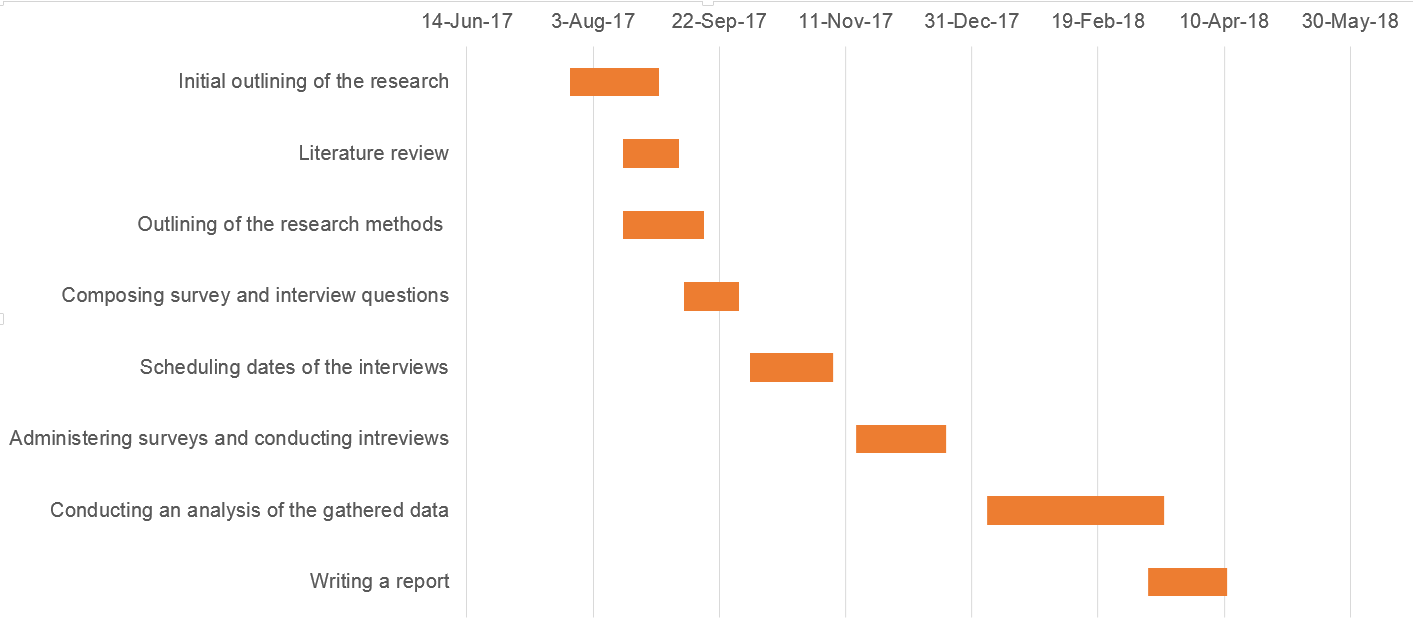
Data Collection
An on-line survey was utilized as the main quantitative data collection tool. The survey included 20 questions with multiple choice, binary, and Likert-scale questions. It was uniquely designed to measure various aspects of attitude towards change management and the level of belief in some of its practices as tools for effective project implementation. It was tailored in accordance with the demands of research needs and goals. The first two questions were designed to gather demographic information such as age and gender. This data was used to establish possible behavioural patterns specific to age and gender groups, which may provide an insight on change management strategies utilized in those groups later in the course of the study.
The next set of questions defined the relation of the participants to managerial or non-managerial position and gathered work-specific information such as the experience on the occupied position and length of a typical working day. This data is also relevant to the study in terms of assessing the relation between patterns of change management utilization and personal managerial experience in the organization. Question 7 addressed printing behaviours of the sample. Questions 8 through 12 aimed to address the second research question related to employee involvement and its effect on time saving, costs and effectiveness of the paperless environment project. Question 13 measures the level of support for paperless environment project using 10-point Likert scale. Questions 14 and 15 assessed the awareness of the participants of change management strength to influence the project on different levels of its implementation. The last set of questions was devoted to technology and its role in organization and in the project. Questions 16 and 17 were designed to inquire about the participant’s views on technological progress and its interrelation with the paperless environment project. Questions 18 through 20 assessed the level of agreement with the assumptions that IT infrastructure, process automation and new technologies influence the projects time, cost, and performance.
The survey was administered via google survey platform. The participants’ anonymity was ensured by the platform itself, which excludes the possibility of data collection and interpretation bias. Through one of the senior managers working at GCAA all managerial staff of the organization was asked to participate in the survey. The process of informing employees was facilitated by corporate mail. A total of 42 emails were sent, which attracted 28 participants. The response rate, therefore, constituted roughly 67%.
An interview was selected as a primary qualitative data collection tool. It featured a total of 5 open-ended questions concerning various aspects change management implementation in the course of paperless environment initiative. Three interviews were conducted with managers of two different departments. Two of the participants were male and one was female. The interview in each case lasted around 15 minutes. The events were scheduled in advance via e-mail and conducted separately with each participant unaware of the other being interviewed. Each interview was recorded with the use of a mobile device and later hand typed into an excel document.
As per the design of the interview questions, all of them were designed in a manner that addresses the research questions put forward in the introductory part of this report. The first question assessed the interviewee’s awareness of change management practices and evaluated the depth his or her personal inclination to consider the possibility of change management to influence reforms within the organization. The second ushered the interviewed manager to elaborate on his view of a subordinate’s involvement in the process of change facilitation. The questions three to five touched the subjects of IT infrastructure, and technology level within the organization in relation to the paperless environment project.
Analysis
Quantitative Data Analysis
The main analysis tool for quantitative data was SPSS statistical package version 23. This software was used to calculate descriptive statistics such as mean, mode, median, standard deviation, variance and quartile range to assess the sample. Since the questionnaire was developed to answer multiple research questions, it consists of several groups of questions with different aims. The analysis was also divided into parts.
The first group of questions is related to demographics and provides statistics on age, gender, position in the company, and experience. As it was already mentioned above, the majority of the respondents were male. However, the frequency differentiation did not exceed 20%, which may testify for the relative gender equality in terms of distribution of managerial positions. Mean and mode age group is 25-35 years old. Standard deviation seems to be within the normal range. The majority of participants serve as managers of a middle class who, according to the data presented in appendix 1 constitute 55% of the sample. Second and third largest groups are department managers and employees with 22 and 18% respectively. Thus, it seems that the research covers a variety of populations ranging from middle to low class managers and their subordinates with the dominance of middle executives. As for the time served in the company, the results of the survey demonstrate that most of the sample has less than 12 months of experience. However, according to the frequency distribution shown on the figure 1, the difference between the three major groups is not significant enough to make a statement of a single group dominance. On the other hand, there is a clear underrepresentation of the people with high level of experience. Only 7% of the sample are serving in the GCAA more than 10 years.
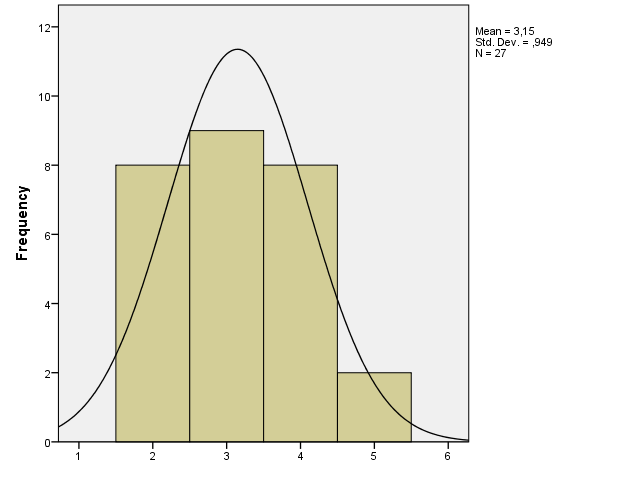
One of the significant issues of the research was the assessment of printing behaviours. Statistically, more than 40% of the participants do not participate in printing processes and do not use hard-copied documents. The second most populous group that accounts for roughly a quarter of the whole sample uses printed documents in only 25% of cases. The last three groups that can be characterized as people with active printing behaviour who use or create printed documents in 50 and more cases out of 100. Figure 3 vividly demonstrates the spread of printing behaviours.
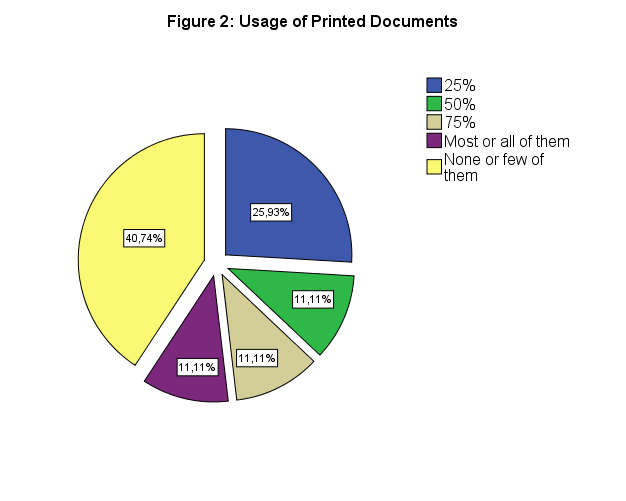
There was also a need to assess printing behaviours for different groups of participants. For this goal, mean and median values were calculated and compared to each other for each different position except Sector managers as there is only one case and calculation of mean or median would have been pointless. Additionally, SPSS mechanism of analysis excluded 48% of the cases as shown in the table 11 in appendix 2. According to the data presented in the table 2, mean and median choices indicate the usage of paper in either 25% of cases or no occasions of printing and using hardcopies. Employees exhibit the tendency to use no paper at all, while department and section managers still continue to use it but infrequently.
Another set of questions addressed the issue of employee involvement in different aspects such as the need for their participation in the process of change management. The main focus was the support of employee’s involvement in the process of change management implementation, and what the result of such action should be expected.
When active involvement of employees was concerned, the data suggests that most of the sample agrees with this kind of change. The answer “strongly agree” seems to dominate among the participants with 20 people out of 27 opting for it. Same trend was observed for the other two questions regarding consideration for employees’ opinion and their impact. The “strongly agree” choice was selected in 19 and 15 cases respectively. The last question in the set also resulted with a positive trend. Mean, median, and mode allow concluding that “all of the above” (meaning better project outcomes, cost and time savings) was the most popular answer across the sample. On frequency distribution histograms in appendix 3, the standard deviation curves demonstrate average clusteredness of the data.
Question 13 evaluated general approval and support of the participants of the paperless environment project. Descriptive statistics indicate that the ultimate number of points on the Likert scale happened to become the most frequently selected.
Table 4: Level of Support for Paperless Environment Project
Questions 14 and 15 revealed high levels of support for change management practices to be implemented at all stages of paperless environment project. The second variant “partly agree” became the primary choice for the majority of respondents (table 5). The appendix 4 that contains frequency tables and histograms reveals that the second priority was given to “strongly agree.” Variance and deviation do not exceed standard values and indicate normal symmetrical distribution in case of CM understanding and are slightly skewed left in CM Usefulness variable chart.
The last portion of quantitative data broadens our understanding of company’s workers’ ideas about technology. According to mean, median, and mode statistics, most of the respondents strongly believe that technology is essential for their workplaces and can potentially increase their routine efficiency. Participants of the survey placed similarly high value on technology, IT infrastructure, and process automation in terms of its influence on PEP implementation, its cost, time, and performance (Table 6). All five frequency histograms have a negative skewness (appendix 5).
Discussion
From the demographical point of view, the sample represents both gender groups, age groups and occupations. The average ‘portrait’ of a GCAA manager according to all statistical calculations would be a 25-35-year-old male or female section manager with less than a year experience. Such type of people seems to be young enough to be open-minded and embrace change. Above that, the level of experience suggests that an average sample representative has worked in the company long enough to know its structure, and have a comprehensive understanding of its inner and outer challenges. It is noteworthy to mention that an analysis of printing behaviour revealed that a majority uses paper as information container infrequently or do not use it completely. Statistically, they constitute more than 66% of the sample, which allows to conclude that the environment for paperless environment implementation is already established. It also allows to notice what a small population of the company’s employees will be affected by the change – 34%. In light of this, the need for intervention could be reconsidered.
When support for the CM and PEP is concerned, the research revealed no significant protest against either of the concepts, which suggests a large capacity of the managerial body to welcome and the eagerness to facilitate change. Together with the overall unchallenged support for change, it is noteworthy to mention a tight connection between CM and PEP in terms of application of the first to the latter. Both scored the highest value that indicates maximum support for the thesis that change management is extremely useful in project execution and implementation in GCAA setting. Above that, the last part of the statistical analysis revealed one of the sources of such desire for change. It appears that the highest scores in technological needs assessment drive the need for change and PEP in particular. Given the understanding and support for CM as a tool for guiding the process of PEP implementation and the more than able sample, it could be assumed that the introduction of the change is underway and has a high chance of success.
The quantitative data analysis provided the desired answers for the research questions. Firstly, it has been evidenced that managers place a high value on CM as a valid tool for implementation and execution of PEP in GCAA. Secondly, active involvement of employees in the process of change facilitation is widely supported across managerial layer. Moreover, the employees themselves are eager to participate in it. Thirdly, almost all representatives of the sample recognize and acknowledge the impact of and the need for new technologies that, according to their common belief will help them be more efficient as professionals (Paul Battaglio and Condrey, 2009). The use of change management as well is considered both a cost-saving and time-saving measure that boosts effectiveness of the upcoming change.
Qualitative Data Analysis
The main tool for qualitative data analysis was Atlas.ti 8. The text of each interview was coded and transformed into concepts. The grounded theory values coding was used to determine patterns and beliefs of the interviewee and make broader suggestions on the research questions and the case environment. Programme tools assisted the process of coding. Usage of open coding tool allowed to outline the initial concepts and link them to citations. The initial outlining revealed approximately 40 concepts, keywords, and beliefs. Some items, as it was expected, were voiced more frequently than others. Appendix six explicitly demonstrates that there were four collocations and words that were identified throughout the interviews five times each. They are as follows:
- asking questions
- environments matter
- satisfaction with current situation
- professional team
The second most frequent codes with three separate appearances in the text are:
- automation=safety
- comfort
- managers know better
- open-mindedness
The rest of the list of initial codes is filled by words and collocations identified twice or once. The coding used all three interviews in a combination, as the interviewees did not represent the populations with sufficient level of diversity to compare their answers against each other in order to reveal differences and similarities between them. Moreover, the three interviewees are the managers of the same organization in closely related departments. Instead, in order to meet the goals of the current research and to test the three hypotheses mentioned in the introduction section, the three interviews were considered as a single text that is segregated logically according to with five different agendas.
To attain a deeper understanding of concepts that constitute the philosophy of the managerial board of GCAA another useful visualization tool was used. Word cloud lets the viewer comprehend the statistical significance though visual channel and assess the value of a certain word in accordance with the closeness of it to the centre of the cloud (Atenstaedt, 2012).
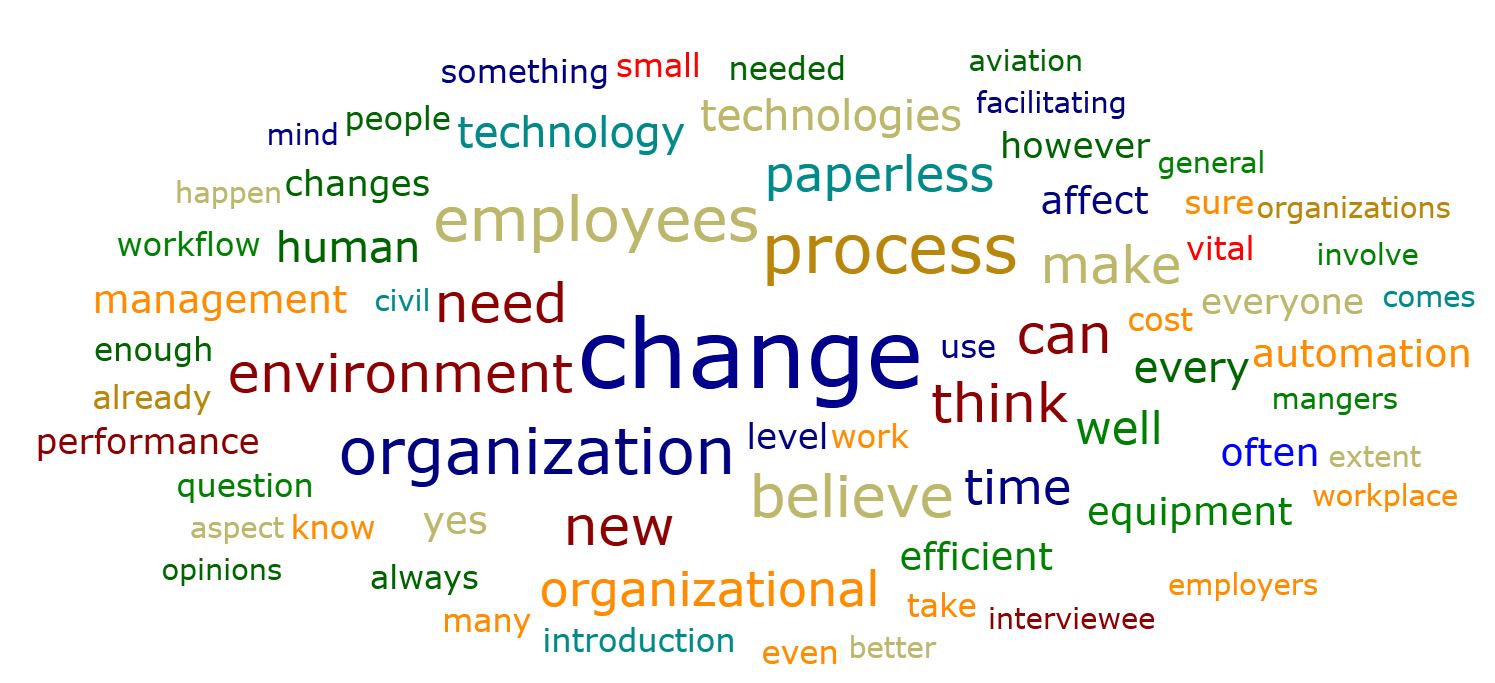
The most essential word is change with 24 occurrences throughout the text. Organization and process are the second most frequently used scoring 14 and 15 uses respectively. These are followed by words employees, need and environment with 13, 11, and 11 uses respectively. Equally important in the list according to the statistical calculations believe, think and can with 12, 11, and 11 uses respectively.
The next step of the qualitative analysis was to unite the concepts into categories to be able to hypothesize on the implications. For this task, code grouping tool was utilized. As a result, six groups emerged:
- Employee-centred CM
- Manager-centred CM
- Environment-centred CM
- Tool-centred CM
- Future-centred CM
- Present-centred CM
Almost all of the concepts found its place within one of these six categories the content of which is located at appendix 7. At this stage, we were able to clusterise conceptual information in order to derive the six main themes or spheres in which change management exists within the structure of GCAA.
In the final stage, two general frameworks of change management could be established. Present-centred and Future-centred paradigms seem to be broader than the other groups can unite them. The final experimental concept-based CM frameworks were organized and viewed in the following manner:
- Present-centred CM
- Employee-centred CM
- Manager-centred CM
- Environment-centred CM
- Tool-centred CM
- Future-centred CM
- Employee-centred CM
- Manager-centred CM
- Environment-centred CM
- Tool-centred CM.
Discussion
The qualitative analysis allowed to reveal the essence of the GCAA managers’ understanding of CM and PEP in their close relation. A uniquely designed 3-step coding approach together with elements of statistical analysis helped crystallize the key terms and collocations that dominate the mind of GCAA employees allowing to comprehend and confirm the conclusions made in the first part of the study. Thus, change has a central place in the framework of everyday conduct and strategic thinking of the interviewed managers. Revolving around the concept of change is change management that, according to coding facilitated by Atlas.ti software, revealed that CM practices generally favour involving employees in the process of change management. However, according to the coded words there seems to be certain nuances concerning change management behaviours.
Consequently, according to the most frequently encountered codes, among managers there is a tendency to place a high value on the opinion of their subordinates. However, this quality is exhibited when there is enough evidence that change directly affects them. Otherwise, managers tend to conceal the fact of change that does not concern their subordinates in order not to disturb them with irrelevant information. Also, they would emphasize the value of the discipline and subordination where respect and rule-following is the key to outstanding performance. This seems to be a part of the “comfort” philosophy that reveals itself through the frequent appearance of this word. All of the interviewed managers directly or indirectly indicated the concern for their subordinates’ performance and acceptable working conditions. Such passion for creating comfort though discipline could be partly explained by the cultural peculiarities of business traditions in the UAE (Bin Taher, Krotov, and Silva, 2015). Interestingly, alongside the overall support for change management and embracing organized change, the same interviewers explicitly stated that both their company environment and the workers are capable of top performance.
Thus, codes “professional team” and “satisfaction with working conditions” were among the top by frequency. This can possibly be explained by the duality of the feelings that managers have towards change. Since they work in highly bureaucratized environment, where change happens extremely rarely, there can be not much experience to relate to in order to formulate a firm position and clear philosophy of change management. The next stage of revealing the nature of change management relation to PEP was grouping the codes. It has also produced fascinating results. The six centres of attention were identified in the conversation with the interviewed managers. There surfaced a certain contradiction between managerial and employee-centred approaches. There seems to be no resolute answer among managers on which model is more preferable. On the one hand, managers tend to listen to their subordinate’s ideas, and on the other hand, do as they see fit because they carry the power and the responsibility.
Apart from that incongruence, managers noted their extreme preference for the environment factor as the key to informed change management decisions. As they suggested, each case of change can be viewed differently and general questions about regard or disregard for certain innovations such as the process of automatisation revealed the inability to give a categorical answer. Instead, most of the answers considered two positions in which the results can be either positive or negative. From one point of view, this position is understandable as harsh judgement is a bad tone.
The tool-centred approach also seems to be accepted by all of the interviewees. CM was reported to be useful either as a tool to conquer bureaucracy, if applied expertly and in the right time, or an instrument for analysis and monitoring change. With such an unlimited range of possibilities for CM application, managers also noted its extreme aptitude for GCAA setting and the PEP in particular. Managers critically appraised technology as a catalyst for organizational change. However, they also expressed concern for possible workplace shortage or the necessity for an updated skillset. The latter seems to be a particularly sensitive issue. From the one side, they assured that their staff is highly competent and interacts with sophisticated equipment daily. However, in the same time, they express concern for possible loss of jobs due to incompetence in the new technological environment and the need to constantly raise their qualification. Such occasional duality in the answers and the desire to give ‘the right’ answer indicates a certain level of insecurity. This is understandable because questions were rather fundamental and one rarely dares to challenge norms. Despite that fact, a concern for structural changes that should precede and facilitate the implementation of smaller ones.
The last section of the qualitative data analysis allowed to have a fresh look on CM in the new context. It allows to remind oneself of the factors that need to be in order for a change to be successful and positive. Defining stakeholders, framework, action plan, and adjusting all of them according to the working environment and the needs of key recipients seems to partly reflect Deming Plan-Do-Check-Act strategy (Sminia and Van Nistelrooij, 2006). Overall, the analysis confirmed the high concern for employee involvement in the process of organizational change, extreme support for technology as a driving force of change, not mentioning the drawbacks, and the usefulness of CM in GCAA setting for PEP.
Implications for further studies. One of the main implications is enlarging the sample. The sample of the current study allows to make assumptions within the borders of GCAA organization while extrapolation is pointless. Other limitations include self-reported status of collected data, which allows to question its validity. However, randomized controlled trials in this setting with limited amount of resources is simply unavailable. Another major flaw is the low attention paid towards employees themselves. Further studies may choose to prioritize the comparison between managerial and non-managerial population within a single public organization. This study will be conducted for a second time in the period of mid-intervention to assess the possible changes in the philosophy from positive and open-minded to sceptical.
Conclusion
All things considered, the study analysed quantitative and qualitative data in order to answer the questions of whether change management is applicable for project management in a public organization. This report constitutes the first step of a longitudinal study that aims to assess the impact of change management though self-reported data on all stages of change implementation. The quantitative data revealed high level of importance attached to the need of change management practice during execution and implementation phase of PEP in GCAA. Employee involvement was also supported almost unanimously. According to the presented descriptive statistics, the value placed on technology as a driver of change is extremely high. All three hypotheses related to the questions were proven to be true. Additional qualitative study performed by analysing the interview transcript through Atlas.ti software once more confirmed the results analysed quantitatively though SPSS statistical package.
Appendix 1
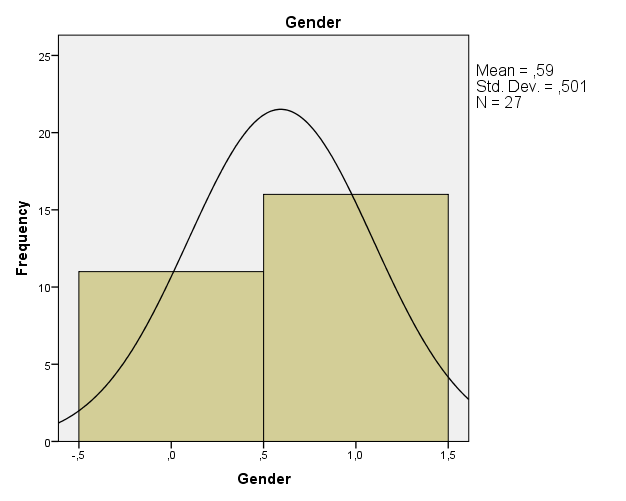
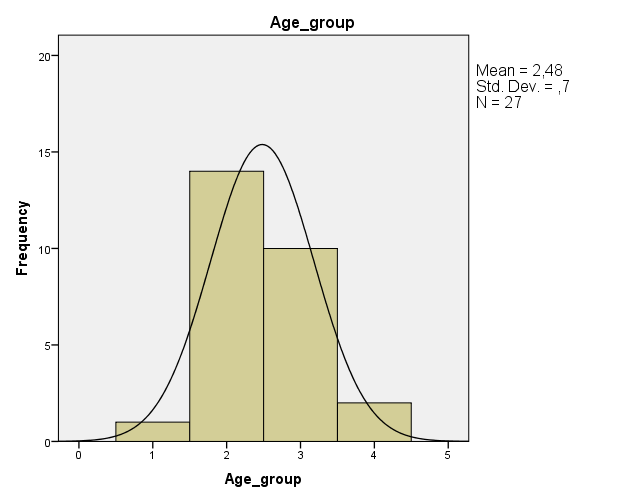
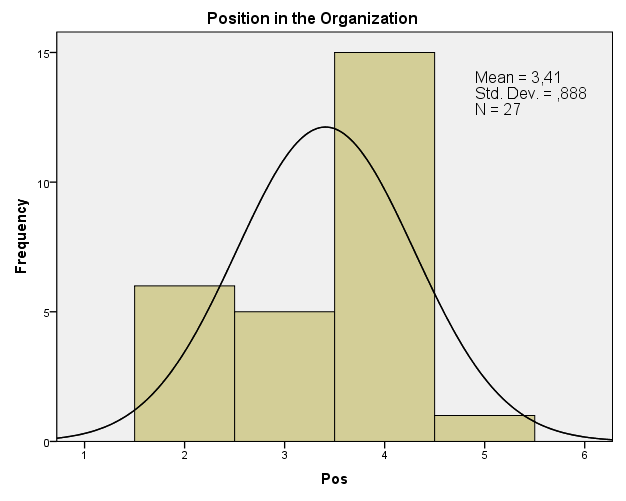

Appendix 2
Appendix 3

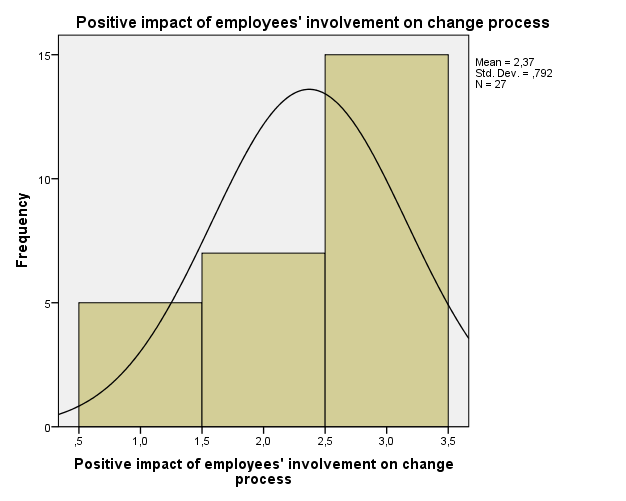
Appendix 4
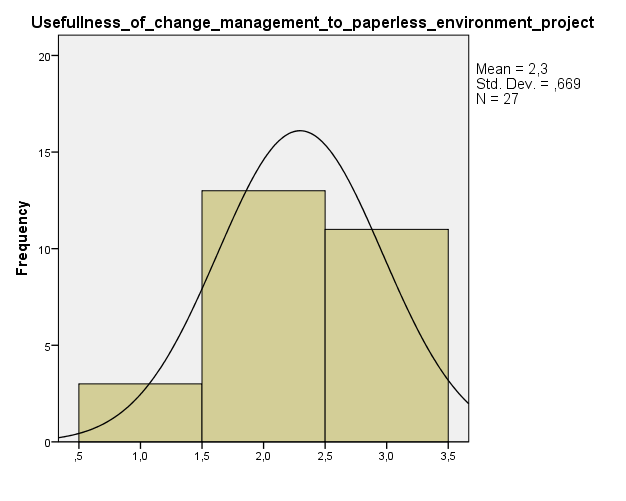
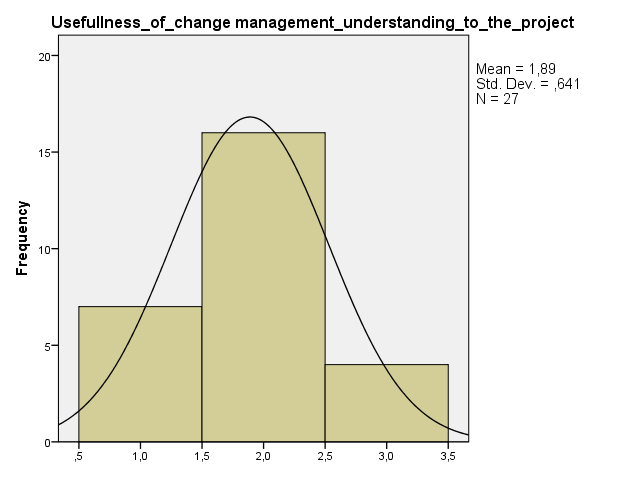
Appendix 5
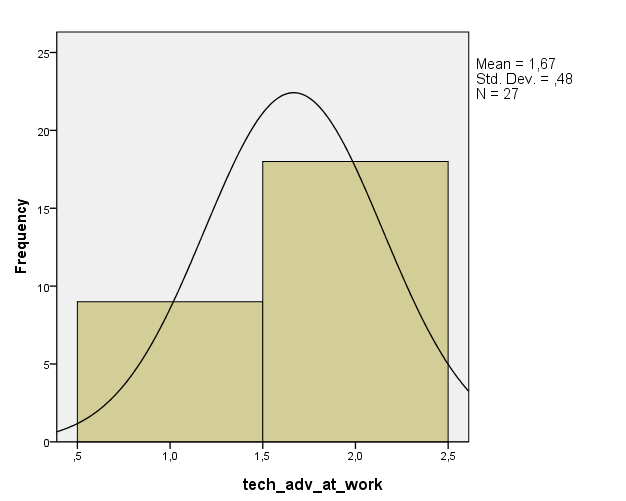

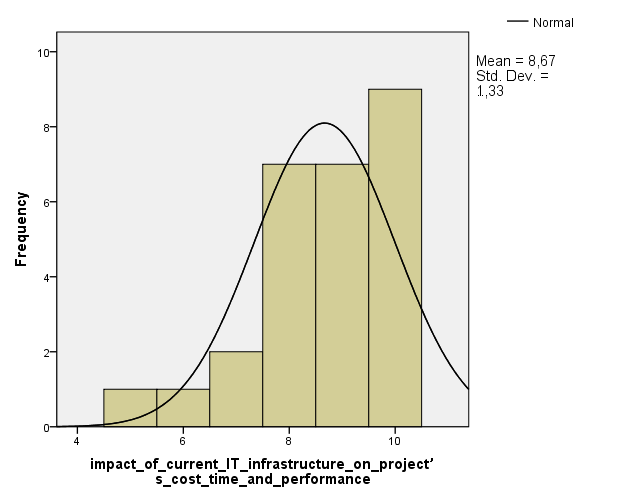
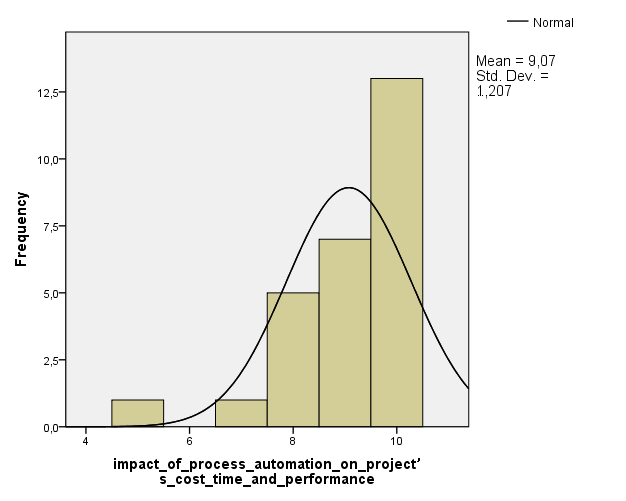
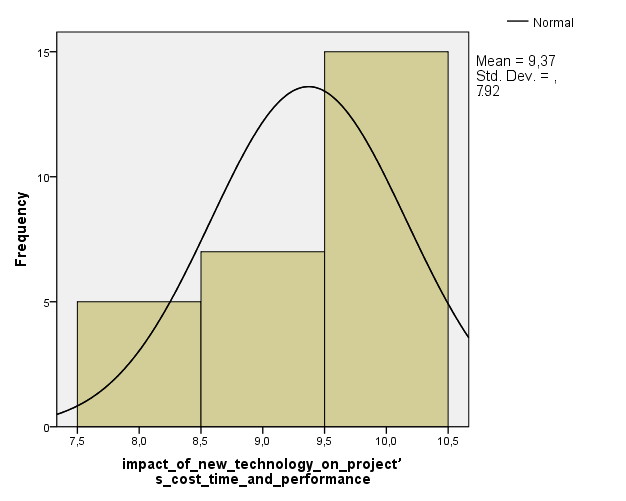
Appendix 6
Table 20. Initial Coding
Appendix 7
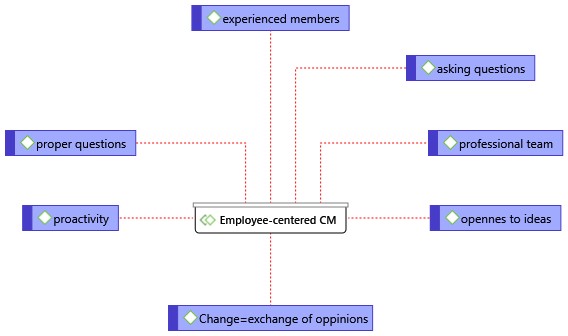
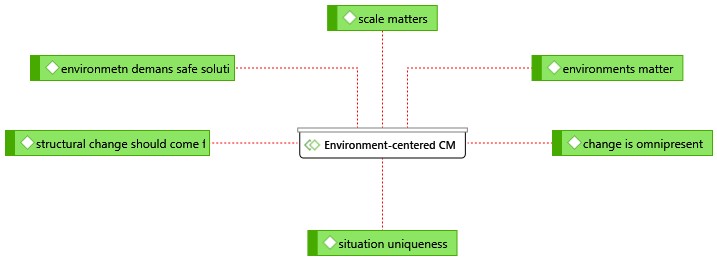
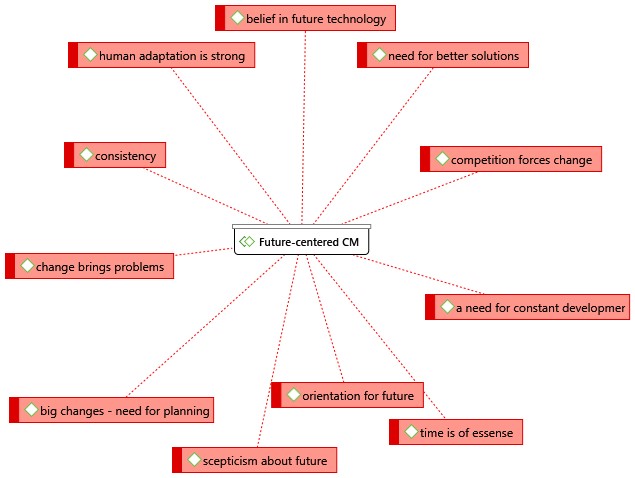
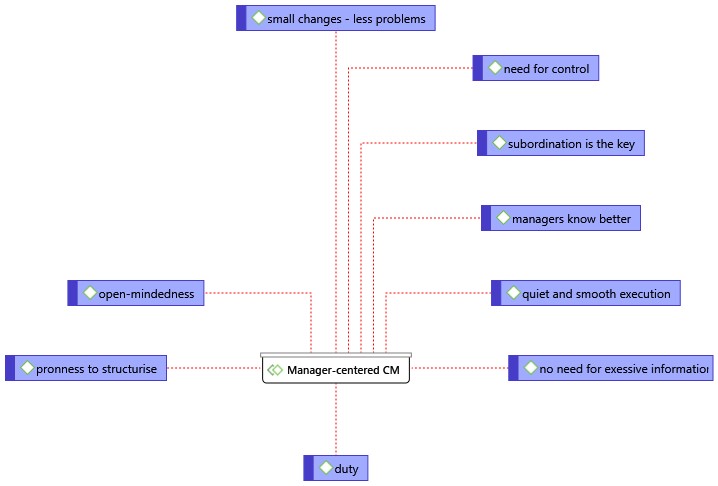
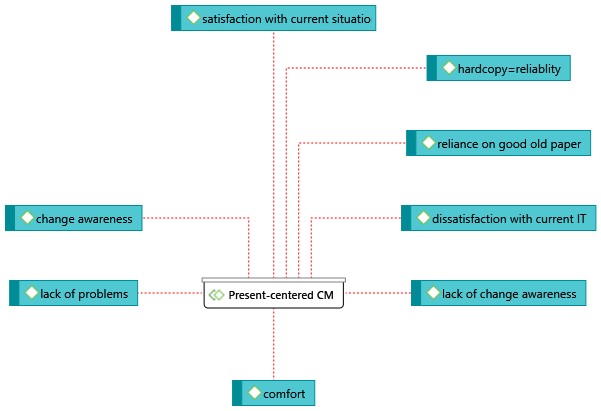

Reference List
Anderson, D. and Anderson, L. (2010) Beyond change management: how to achieve breakthrough results through conscious change leadership. Hoboken: John Wiley and Sons.
Arain, F.M. and Low, S. P. (2009) It-based project change management system. New York: Nova Science Publishers, Inc.
Association of Change Management Professionals (ACMP) (n.d.) ‘The standard for change management’. Web.
Atenstaedt, R. (2012) ‘Word cloud analysis of the BJGP’. The British Journal of General Practice, 62(596), pp. 148-159.
Bin Taher, N., Krotov, V. and Silva, L. (2015) ‘A framework for leading change in the UAE public sector’, International Journal of Organizational Analysis, 23(3), pp.348-363.
Bryman, A. and Bell, E. (2015) Business research methods. Oxford: Oxford University Press.
Cichocki, A., Ansari, H.A., Rusinkiewicz, M. and Woelk, D. (2012) Workflow and process automation: concepts and technology. New York: Springer Science & Business Media.
Cook, S., Macaulay, S. and Coldicott, H. (2004) Change management excellence: using the four intelligences for successful organizational change. London: Kogan Page.
Easterby-Smith, M., Thorpe, R. and Jackson, P.R., (2012). Management research. New York: Sage.
Foster, R.D. (2010) ‘Resistance, justice, and commitment to change’, Human Resource Development Quarterly, 21(1), pp. 3-39.
GCAA. (2017a) ‘Action plan for paperless project’. Available at: private access within the organization only
GCAA. (2017b) ‘GCAA knowledge management strategy’. Available at: private access within the organization only
GCAA. (2017c) ‘Paperless environment project charter’. Available at: private access within the organization only
Kang, S. (2015) ‘Change management: term confusion and new classifications’, Performance Improvement, 54(3), pp.26-32.
Kuipers, B. S., Higgs, M., Kickert, W., Tummers, L., Grandia, J. and Van Der Voet, J. (2014) ‘The management of change in public organizations: a literature review’, Public Administration, 92(1), pp. 1–20.
Larsen, T. and Eskerod, P. (2016) ‘Using change management principles in projects – an exploratory case study’, Journal of Management and Change, 35 (2), pp. 44-59.
Merdzanovska, M. (2016) ‘Dealing with change resistance’, Economic Development, 18 (2), pp. 393-406.
Myers, M.D. (2013) Qualitative research in business and management, Sage, London.
Paul Battaglio Jr, R. and Condrey, S.E. (2009) ‘Reforming public management: Analyzing the impact of public service reform on organizational and managerial trust’, Journal of Public Administration Research and Theory, 19(4), pp.689-707.
Phillips, J. R. (1983) ‘Enhancing the effectiveness of organizational change management’, Human Resources Management, 22, pp. 183–199.
Powell, G. and Posner, B. (1978) ‘Resistance to change reconsidered: implications for managers’, Human Resource Management, 17(1), pp. 29-34.
Sminia, H. and Van Nistelrooij, A. (2006) ‘Strategic management and organization development: planned change in a public sector organization’, Journal of Change Management, 6(1), pp. 99-113.
Van der Voet, J., Kuipers, B. S., Groeneveld, S. (2016) ‘Implementing change in public organizations: the relationship between leadership and affective commitment to change in a public sector context’, Public Management Review 18, pp. 842–865.
Zou, Y. and Lee, S. (2008) ‘The impacts of change management practices on project change cost performance’, Construction Management and Economics, 26(4), pp. 387-393.
